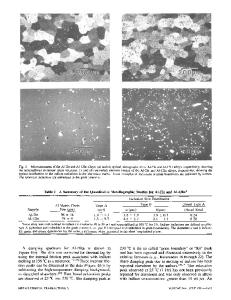Room temperature creep of Ti-6AI-4V
- PDF / 1,006,121 Bytes
- 7 Pages / 612 x 792 pts (letter) Page_size
- 94 Downloads / 344 Views
OBSERVATION of room temperature c r e e p in titanium alloys such as Ti-6A1-4V has been reported by s e v e r a l authors;1-7 however, considerable controversy s t i l l exists concerning the occurrence of room temperature creep. For example, Wood2,3 reported that room temperature c r e e p o c c u r r e d in Ti-6A1-4V at torsion s h e a r stresses as low as 10 pct of the yield stress. However, Riemann 6 recently reported with torsion testing that room temperature c r e e p below the yield s t r e s s did not o c c u r at all if the loading was unidirectional, but room temperature c r e e p did o c c u r if the s t r e s s was r e v e r s e d a f t e r exceeding the yield stress in the forward direction. Odegard and Thompson7 disputed Riemann's results on the b a s i s of t h e i r observation of room temperature c r e e p at tensile stresses of about 60 pct of the yield s t r e s s . Since room temperature creep of Ti-6A1-4V had been obs e r v e d in this laboratory2,3 and because t h e r e were indications that microstructure was an important v a r i able w e decided t o test these divergent results and perform additional tests of room temperature c r e e p in Ti-6A1-4V of varying microstructure. EXPERIMENTAL PROCEDURE The specimens for these tests were thin walledseamless tubes of 0.635 c m O D and 0.538 c m ID. The tube was cold drawn with reductions of 25 to 30 pct per pass. The tube was mill annealed in vacuum at 800°C for two h. The chemical composition of the
Ti-6AI-4V alloy in wt pet was: A1 V O N 5.8 4.4 0.113 69 ppm
C 0.02
N 0.010
Fe 0.08
In this work we wanted t o see how the c r e e p rate and the total amount of c r e e p were dependent upon microstructure. We chose to investigate t h r e e microstructures resulting from different annealing treatments: a-ri anneal (ariA), recrystallization anneal (RA), and ri-anneal (riA). The procedures for these annealing treatments were as follows:
a-ri Anneal (ariA) 800°C (1472°F) for 3 h, furnace cool (FC) to 600°C M.A. IMAM and C. M.GILMORE are ResearchScientistand Associate Professor, School ofEngineeringand Applied Science, The George Washington University, Washington, D.C. 20052. Manuscript submittedMay 16, 1977. METALLURGICAL TRANSACTIONS A
(ll12°F), followed by a i r cool (AC) t o room temperature. Recrystallization Anneal (RA) 928°C (1702°F) for 4 h, FC to 760°C (1400°F) at 180°C/h, FC t o 482°C (900°F) at 372°C/h, AC to room temperature. ri-anneal (riA) 0.5 h at 1037°C (1900°F), AC to room temperature, 732°C (1350°F) for 2 h, AC to room temperature. The microstructures produced by these t h r e e annealing treatments a r e shown in F i g s . 1 to 3. T h e s e micrographs are of the outside tube s u r f a c e with the longitudinal direction horizontal. In these micrographs the a (hcp) phase is dark and the /3 (bcc) phase appears bright. The recrystallize anneal and the a-ri anneal b o t h have relatively equiaxed a - g r a i n s . This indicates that the a - g r a i n s in b o t h of these metals had been recrystallized, otherwise axially elongated
Data Loading...











